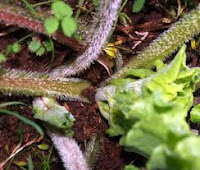Red currants are very closely related to blackcurrants, Ribes nigrum and the other sweeter variety, white currants. They are a gorgeous glossy red jewel-like fruit which can be eaten raw, but they are bitter, so mostly cooked. They can be mixed with blackcurrants in pies and jams, or used alone. They should not be confused with cranberries, although you can make a delicious red currant jelly that can be used with meat dishes. Like blackcurrants they are members of the Grossulariaceae or gooseberry (the European kind) family.
Red currants are native to north, central Europe and northern Asia ; they were first cultivated in Scandinavia and were introduced to the London
 They were cultivated not only for their edible qualities but for medicinal purposes as well as they have 4 times as much vitamin C as an orange when compared by weight, so were useful to combat scurvy which is due to a vitamin C deficiency which was more prevalent in the 16th and 17th centuries. Red currants also contain the mineral magnesium which is essential for the health of bones, nerves muscles and the healthy functioning of the heart. It also helps to regulate blood pressure and levels of blood sugar. Vitamin C of course helps to boost the immune system and has antioxidant properties which help protect the body from scavenging free-radicals which can damage healthy cells and cause cancers. It also boosts the body’s production of collagen which puts life back in to tired, jaded skin. Vitamin C is also essential for wound healing. Red currants are also rich in potassium which also helps to regulate blood pressure and promotes a healthy heart, bones’ and muscles’ contraction and aids digestion.
They were cultivated not only for their edible qualities but for medicinal purposes as well as they have 4 times as much vitamin C as an orange when compared by weight, so were useful to combat scurvy which is due to a vitamin C deficiency which was more prevalent in the 16th and 17th centuries. Red currants also contain the mineral magnesium which is essential for the health of bones, nerves muscles and the healthy functioning of the heart. It also helps to regulate blood pressure and levels of blood sugar. Vitamin C of course helps to boost the immune system and has antioxidant properties which help protect the body from scavenging free-radicals which can damage healthy cells and cause cancers. It also boosts the body’s production of collagen which puts life back in to tired, jaded skin. Vitamin C is also essential for wound healing. Red currants are also rich in potassium which also helps to regulate blood pressure and promotes a healthy heart, bones’ and muscles’ contraction and aids digestion. Red currants also contain traces of the minerals zinc, selenium, copper, manganese, and some phosphorous while also containing some of the B-complex vitamins, vitamin K and a little vitamin A, along with amino acids.
Red currants also contain traces of the minerals zinc, selenium, copper, manganese, and some phosphorous while also containing some of the B-complex vitamins, vitamin K and a little vitamin A, along with amino acids. The fresh leaves of the red currant bush contain the toxin hydrogen cyanide, but this is not dangerous in small doses. In small quantities it can help improve digestion and it is claimed that it has a place in cancer treatments. However an overdose can result in respiratory failure be fatal.
The berries have a mild laxative effect and contain sugars and dietary fibre, so are a good, no-fat, no-cholesterol, and low-calorie food for those on a weight-loss diet. The leaves can be chopped and made into a tisane (fresh or dried) and used as a diuretic or to relieve the pain of inflammation in rheumatism. The leaves can be warmed and put into a poultice and placed on painful rheumatic joints and are also used to relieve the pain and swellings resulting from sprains or dislocated joints.
 If you pulp the fresh berries you can make a face mask (leave it on for 20 to 30 minutes before rinsing off with tepid water, then splashing your face with cold water) which will leaves your skin feeling fresher and more elastic. A yellow dye can be obtained from the leaves and a black one from the fruit- although it would be better if you found ways of eating the berries rather than using them in this way.
If you pulp the fresh berries you can make a face mask (leave it on for 20 to 30 minutes before rinsing off with tepid water, then splashing your face with cold water) which will leaves your skin feeling fresher and more elastic. A yellow dye can be obtained from the leaves and a black one from the fruit- although it would be better if you found ways of eating the berries rather than using them in this way. You can poach red currants in a little water, cooking them for about 4 minutes or until they just begin to burst and sprinkle them with sugar and serve with cream for a really quick, easy dessert, or pour them over ice cream or try this simple recipe for a Red Currant Fool.
RED CURRANT FOOL
Ingredients
750 gr red currants removed from stalks
2 tsps vanilla extract
4 tbsps icing sugar (or confectioner’s sugar)
200 ml double or whipping cream
200 ml natural Greek yoghurt (thick natural yoghurt)
Method
Separate the fruit and put two-thirds of it into a blander with 2 tbsps of the sugar and blend to a puree.
Whip the cream until it is stiff then add the vanilla extract and the remaining sugar and whisk until stiff again.
Add the yoghurt and fruit puree to this and mix in well. Fold in the remaining fruit, leaving some to decorate the top of the fool with, and mix well.
Spoon into individual glasses and refrigerate until ready to serve.
This has Taste and is a Treat.




































